
Picture perfect start. Photo Andrea Francolini/CYCA.

Offshore Safety – Category 1 vs Category 2
With the offshore season coming up soon, it’s time for all people contemplating going offshore to look at their safety equipment and training again. Not only is it a good time to consider existing safety equipment, it is also an opportune time to consider changes to safety regulations and developments in equipment. Each year safety regulations are tweaked to remain current, and to enhance sailor safety as much as possible. These changes and advancements in technology and processes mean the sport of sailing is getting safer each year. In addition, the start of the season is a good time to check that each sailor on a yacht has the necessary (and current) safety training. Not only is that training a necessary requirement for participating in races, it is essential in the case of an emergency. It is trite but true that good, well maintained equipment, and sufficiently trained crew members could save your life.
In this article I look at the differences and similarities between Category 2 (coastal) and Category 1 (offshore) safety regulations and requirements. Those regulations obviously inform any decision as to the suitability of existing equipment, and/or the need to acquire new equipment. The regulations also dictate what training and retraining each crew member requires.
I also highlight some of the tactical safety considerations any sailor should think about when planning their offshore season.
When I first began planning this article I intended to call it “A Step Too Far.” My initial impression was that the regulatory differences between categories of racing meant that moving from Cat 2 to Cat 1 was a complicated and expensive process. However, as I delved into this topic in more detail, I discover that such a shift is actually surprisingly easy.
What do the different categories mean?
Racing in Australia can be broadly divided in to three groups, inshore (Category 3), coastal (Category 2), and offshore (Category 1).
Racing in coastal water means that help and/or shelter is not too far away. There are often many bays and harbours within a few hours’ reach. However, in races such as Cabbage Tree Island (part of the Bluewater Pointscore Series), yachts can still encounter difficult weather. For this reason, no one participating in such a race should take their safety preparations lightly. Recognising both the relative easy “bail out” options, and the possibility of harsh conditions, the Cat 2 regulations require yachts to carry a comprehensive array of equipment. At the same time, the regulations also take into account the fact that help is likely to be close by.
Stepping up from category 2 to category 1
Stepping up from coastal racing to offshore races such as the Sydney Hobart, a greater level of preparation is required. This is so because significant proportions of those races take place a long way from help; yachts participating in these races need a great level of self-sufficiency. Again, the additional requirements of the Cat 1 safety regulations cover the differences between coastal and offshore racing in a comprehensive, yet reasonable, way.
The Yachting Australia special regulations applicable to Cat 1 races also contain additional, albeit minor, requirements for yacht structural integrity and stability from those required for Cat 2 races. Although not covered by this article, sailors should always check they meet those requirements before submitting any application to participate in an offshore race.
As to the additional safety equipment, the additional items required for Cat 1 races are surprisingly few. Essentially, all that is required are an additional torch, a more comprehensive medical kit, and a few more flares.
The more extensive differences relate to crew training. As noted above, the conditions the crew could face could be significantly more dangerous in offshore races than in Cat 2 races. For this reason it makes sense that Yachting Australia requires more of the crew to have greater training when participating in Cat 1 races. Untrained crew members are not only a risk to themselves, they also pose safety risks to their fellow crew members and any rescuers.
To participate in a Cat 1 race in Australia, 50% of the crew of each yacht must have undertaken a Yachting Australia safety and sea survival course. In addition, the boat is required to have two licensed radio operators instead of the one required for Cat 2 races. Finally, two of the crew members must hold a recognised first aid certificate. Again, all these additional requirements make sense in the context of the more dangerous conditions which sailors may face in offshore races as compared to coastal races. In addition, the differences recognise that a stricken yacht may have to be self-sufficient for a longer period of time when participating in a Cat 1 race than it would do in a Cat 2 race. In the event of an emergency, having two radio operators means they can man the radio in shifts, thus prolonging the time they can communicate with other vessels and the shore. Hopefully, enabling the radio operators to have some periods of rest will increase the accuracy of their broadcasts and make them more alert when receiving transmissions.
People matter
The focus on crew training and development in category 1 races reflects the reality that in the case of an emergency at sea more problems arise because of, and more people are harmed by, the actions of their fellow crew members than lack of specialised safety equipment.
If you are deciding to go offshore, keep this in mind when deciding which race to participate in and with whom. If the whole of a yacht’s crew is new to offshore races, they should think carefully whether each crew member, or a substantial number of them, should participate in some races with more experienced crews. As the old adage has it, there is no substitute for experience. In the case of any emergency, the more experience each crew member has, the more likely they are to remember their training and be more seasoned to the conditions. In addition, they may have experienced different approaches to certain situations. This way if a situation arises and one solution does not work, they will be able to rely on that experience to try different methods.
As the skipper of a yacht contemplating an offshore race, such crew decisions are also key. Not only are there issues about who should sail in each event, but the skipper should also think about rostering and who should be on watch at any time. Ideally, the two radio operators should be on opposite watches so one is as fresh as possible when the other is at their most tired.
In addition, the most inexperienced crew member should be on watch with the most experienced crew member. After that decision is made, the skipper should think carefully about other watch pairs: while it is tempting to continue pairing least experienced with most, this may not work if it means two only mildly experienced crew members will be on watch together.
Don’t let the step up from Category 2 to Category 1 be the reason for not participating, in fact if you can get to Cat 2, you are almost there. The bigger considerations are crew selection and training.
Consider your crew carefully and try to undertake the training as a team together, this will help your crew come together and work together.
– Ross Vickers

ALSO ON MYSAILING
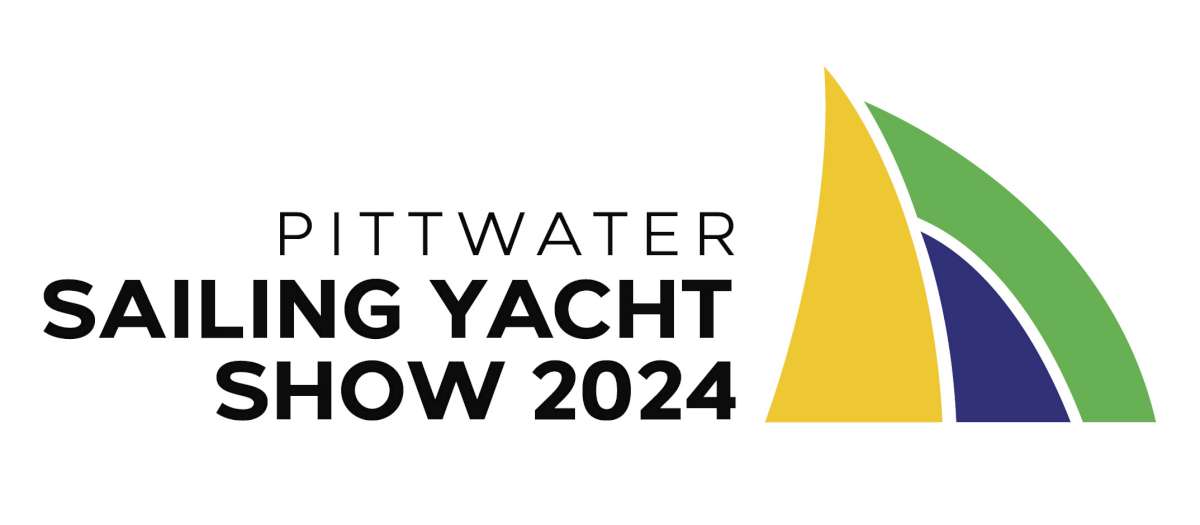
2024 Pittwater Sailing Yacht Show!

2024 NSW O’pen Skiff Championships

Best of the best to contest national yachting title in Newcastle

OGR – Winners and Losers on Leg 4
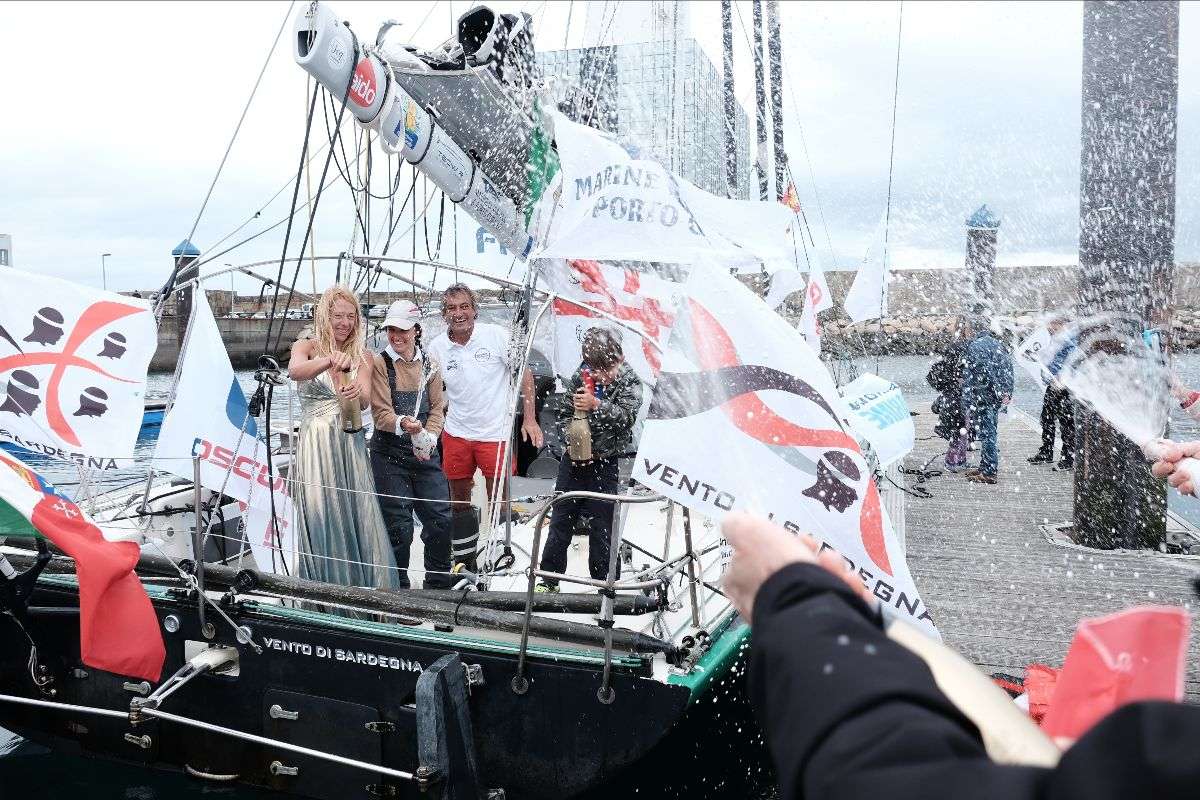
GSC – Andrea Mura reclaims joy on podium
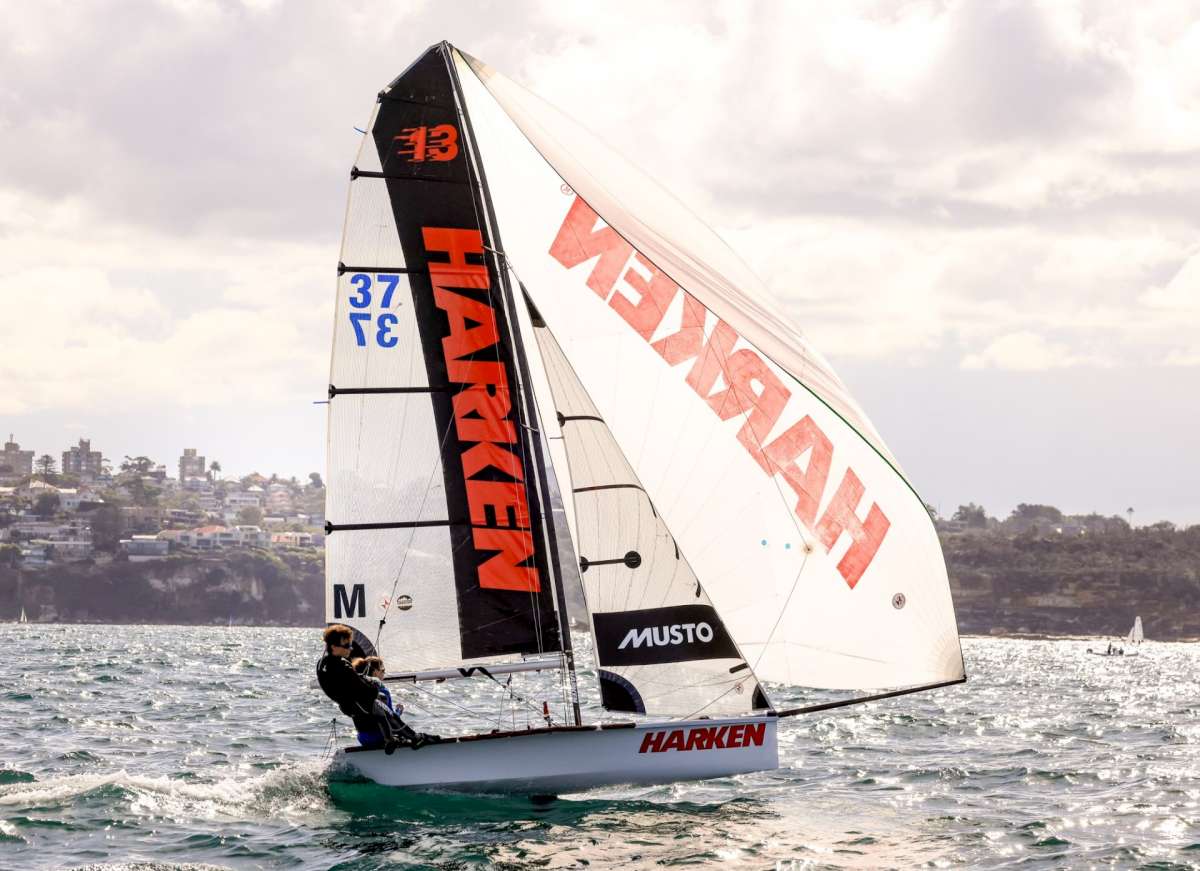
Final Club Championship results at Manly 16ft Skiff Sailing Club
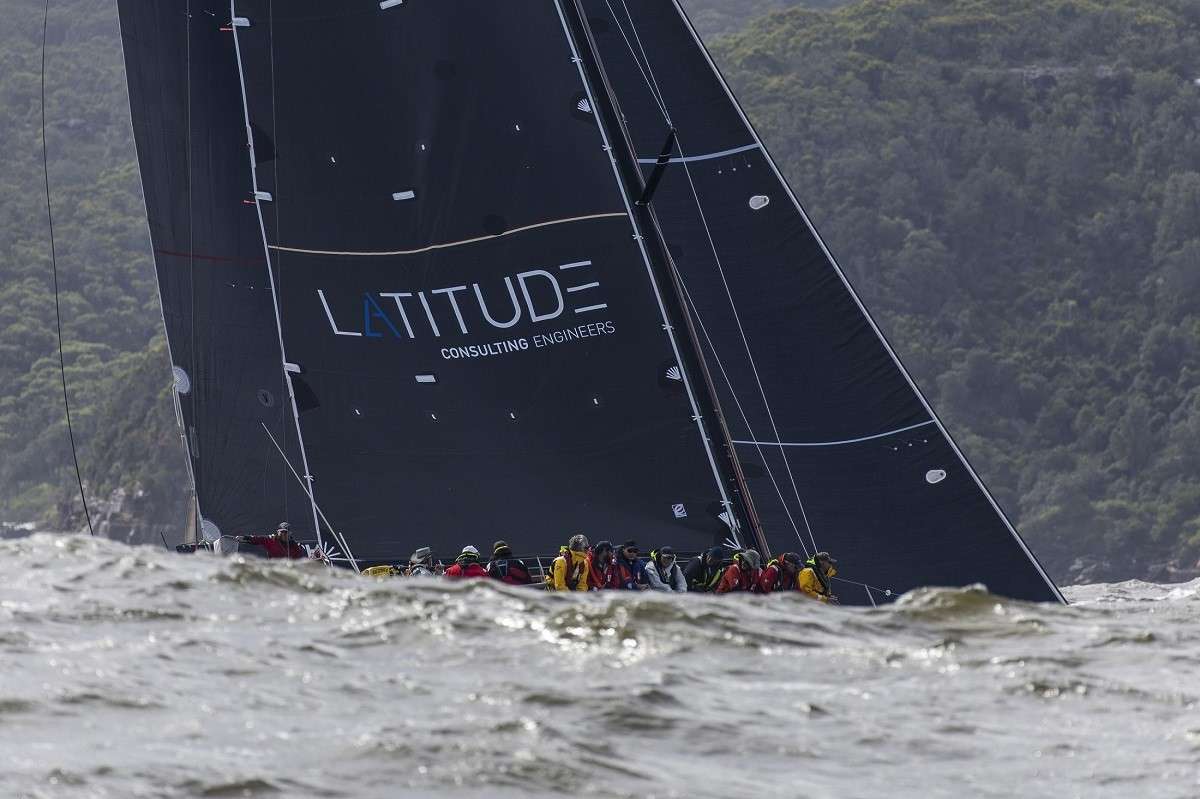
Race is on to win 2024 Pittwater to Coffs Harbour Yacht Race

Outteridge takes the wheel as Schneiter steps back for remainder of Season 4
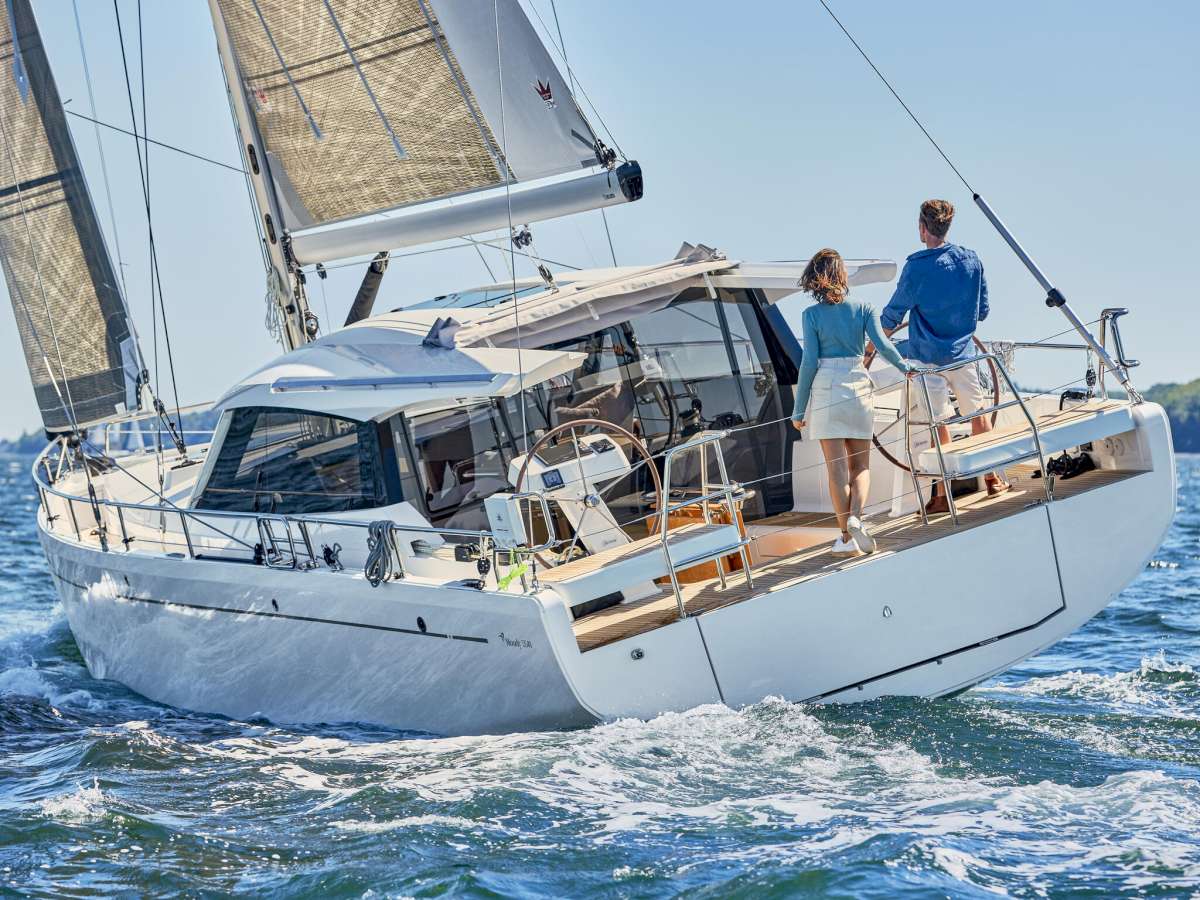
Windcraft presents award-winning sail and power line-up at 2024 Auckland Boat Show

Step into the World of Exploration Boating with the RAND Roamer 29

Tasmanian Sailing – Weekend Wrap

12ft Skiff – Father and son finish top two in NSW Sprint Championship
Join Our Newsletter
- Name First Last
- Name This field is for validation purposes and should be left unchanged.

Read all of the latest sailing news

Dinghy and Yacht Racing News

News from the offshore world

Cruising Stories from around the world

Boats & Gear
The latest boats and yachting gear

Watch everything sailing and boating
Latest Sailing News, Racing, Cruising, Boats, Gear and more

- Recreational
Taking your boat overseas
- Safer Boating Week
- Types of lifejackets
- Check your lifejackets
- Surviving in cold water
- Are you VHF ready
- Buying a VHF radio
- VHF radio limits
- VHF courses and resources
- Mobile apps for boaties
- Check your gear
- Understanding weather forecasts
- Boaties out of their depth with alcohol
- Alcohol contributes to drowning
- PWC kills joyriding teenager
- Fatal capsize on fishing trip
- Horseplay ends in drowning
- Lake Kaniere skiing and swimming areas
- Wairarapa rivers
- Crossing the bar
- Applying to hold a temporary maritime event
- You and your boat
- Skipper responsibilities
- Before you head out
- Environment
- Rules on the water
- Boating courses
Information for:
Your requirements
If you need to obtain a Category 1 Safety Certificate, please click here .
If you already have a Category 1 Safety Certificate and need to register your vessel, please click here .
If you already have a Category 1 Safety Certificate, have registered your vessel, and need to provide a notification of your upcoming departure, please click here .
If you are the master of a pleasure craft that you intend to take offshore, there are a number of safety and administrative matters that must be taken care of before you can depart.
Under section 21 of the Maritime Transport Act, a master of a pleasure craft must notify the Director of Maritime New Zealand of their intention to depart New Zealand before they leave. Additionally, they must also:
- satisfy the Director that the vessel and its safety equipment are adequate for the voyage; and
- satisfy the Director that the vessel is adequately crewed for the voyage; and
- observe any other relevant maritime rules.
All NZ registered vessels must undergo a safety inspection prior to departure to obtain a Category 1 safety certificate. The inspection will focus on:
- the design and construction of the boat being suitable for the voyage and meeting the required standards
- the safety and communication equipment meeting specific requirements and ensuring all safety equipment is well within its expiry date
- the skipper and crews’ ability to undertake the proposed voyage safely and demonstrate preparedness for emergency situations.
The decision on whether to grant section 21 clearance is made by the Director, or their delegate, (i.e. a Yacht Inspector).
In addition to the above requirements, all vessels must be registered as a New Zealand ship with the Registrar of Ships at Maritime New Zealand (MNZ).
To understand what you need to do, download the below flow chart to assist you in following the correct process to obtain a Category 1 safety certificate to take your boat overseas.
Registration
Registering your vessel will give you the protection of the New Zealand Government. The registration papers will provide proof of identity similar to a passport.
Register now
Inspections and obtaining a Category 1 safety certificate
The main purpose of the safety inspection is to ensure those departing remain as safe as possible throughout the voyage, and that they can get help if anything goes seriously wrong.
In order to perform a thorough inspection, the vessel must be out of the water.
Who inspects vessels?
The inspections are conducted by inspectors approved by Yachting New Zealand under delegation from the Director of Maritime NZ. There is a nationwide network of inspectors who are available to provide advice and assistance with any aspect of sailing or power vessel safety.
We encourage masters to engage with Yachting New Zealand early in the process so that they can support you throughout and ensure any last-minute problems can be avoided.
Click the link below to go to the Yachting New Zealand website to find out what Category 1 requirements consist of and to contact an inspector.
Get a safety inspection
Notifying maritime nz.
All masters must notify Maritime NZ of their intended departure.
Please click the button below to complete an intention to depart notification form.
Intention to depart notification form
The Director’s guidelines
The Maritime New Zealand Director’s Guidelines covers both legal and operational considerations when conducting section 21 inspections. The guidelines also cover the technical maritime criteria to be applied when conducting section 21 inspections. The Director’s Guidelines are complementary to, and must be considered alongside Yachting New Zealand’s Safety Regulations of Sailing.
Other information
Please also refer to other important information below.
Ballast water management
If your vessel can carry non-permanent ballast water, and will be going overseas, you may have to ensure that the ballast water management systems onboard meet international standards.
Find out more on ballast water management
Information on NZ Customs requirements for vessels departing New Zealand can be found on their website.
Related information:

Prep and maintain your boat
Learn how to keep your boat in safe working condition.

Check your gear and prepare
Know what gear you need onboard and how to keep it in good working order.
Astrolabe Sailing
Sailing, yachts, adventure and sailing around the world, yachting nz cat 1.
If you own a New Zealand registered yacht and are planning on sailing it offshore, you need to comply with the Yachting NZ Category 1 safety regulations.
As NZ is many hundreds of miles from any other countries, these safety regulations mean that boats are seaworthy and equipped with all the gear needed to make an offshore passage, and the crew are competent, and able to make the voyage.
Internationally registered yachts are exempt from this requirement, and they can leave without this inspection.
There is also Category 2 – which after you clear out of the country Category 1 status reverts to Category 2, and there is also Cat 3, 4 and 5 for shorter coastal trips and sailing around the harbour.
The inspection needs to be done while the yacht is out of the water, and once it has been done it lasts for a month – so you need to get the inspection done just before you plan on heading overseas. This means that you need to be pretty well prepared before the inspection to avoid any surprises which could delay intended your departure date. It is worth engaging the services of your inspector early on in the process to seek their advice on any things that could be of concern and to give yourself plenty of time to get prepared for the final inspection.
There are heaps of things that need to be checked, from the structure and stability of the yacht, right down to the equipment held on board. You can download the rules here :
I have noted some of the major points below. There are also some structural standard requirements as well. Modern boats are made to CE ratings . You want category A for ocean going vessels.
Having the original design plans can be handy as can any stability reports.
- Steering – the rudder will be checked for strength, there must be an emergency steering facility, and any alternative steering methods need to be demonstrated by the crew
- Keel – documents and designs of the keel could be requested, the keelbolts should be accessible and able to be inspected and tightened
- Decks – there are lots of structural things that will be checked in regards to the deck.
- Cockpit and Companionway – Washboards should be able to be secured in position with the hatch open or shut, and secured to the yacht with a lanyard to prevent loss overboard. The hatch should have a strong securing lock which is operable from above or below. Cockpits should be self draining – and there are also more structural things that will be checked.
- Hull – the designer plans are useful here and again lots of structural checks will be performed.
- Flood Protection – the hull should be able to be made in to a water tight unit, hatches should be of adequate strength and able to be opened as an emergency exit, there should be bilge pumps in appropriate areas as well as two manually operated pumps which can be operated from outside. The bilge pump handle must have a lanyard. You must also have four sturdy buckets with a lanyard and 9ltrs capacity
- Mast Step & Chain Plates – the mast must be adequately stepped, preferrably spanning several floors, chain plates must be through bolted, the anchor fairlead must be low chafe, there should be a water tight mast collar.
- Masts, Spars, Rigging & Sails – Rigging should be to appropriate specs, shackles should have split pins, yachts with self furling sails shall have a separate means of setting a trysail and storm jib. Masts should have at least two halyards, bulldog clips for emergency repairs or non-stretch rope should be carried. You should have tools able to sever standing rigging from the hull – axe , hacksaw and 10 blades, hammer & drift, bolt cutters , Bosuns chair . Storm sails should be orange – one trysail and a separate trysail track with a spare main halyard. One storm jib and a heavy weather jib. A reef in the main of at least 50%, and a sail repair kit .
- Accommodation – ability to exit due to a fire in the galley or engine, toilet, bunks and lee cloths, ventilation, stove with safe fuel shut off valve, gas installed by a registered fitter, turn gas off at the bottle sign, galley facilities including a sink, water tanks and the ability to divide in to two separate containers, stored water of at least 2l per person per day for the duration of the voyage, ballast and heavy equipment stowed, yachts name on life jackets, harnesses and life buoys, LPG locker with vapor proof barrier and marked accordingly – just for use of LPG.
- Safety Systems and Equipment – three fire extinguishers – serviced and tested, fire blanket, lifejackets for all crew with light attached, splash hood, crotch strap & whistle, harness and jacklines for all crew – double clipped, names on harnesses and no longer than 2m, 3 hook tethers to be carried for at least 1/3 of the crew. survival suit or thermotic floation clothing recommended. Life raft capable of carrying entire crew – stowed on deck, painter attached to a substantion through bolted fitting and certificate of service. At least one life buoy marked with yacht name and fitted with drogue, pealess whistle, and self igniting light, one additional life buoy with drogue, pealess whistle, light, dye marker or pole with flag, heaving line – brightly coloured line with float at one end. Emergency knife in cockpit, axe, second emergency knife.
- Medical kit and Marine Medic training for at least 50% of the crew.
- Safety rails – handrails on deck, life lines and staunchions of a specific height, jack stays, toe rails, 2 x anchors with chain at least the length of the yacht and 60m of extra rope or chain, a second cable of 6m chain and 40m of rope or chain ready for use at any time and securely fastened.
- Sea Anchor or drogue or another device.
- Communications – SSB radio, VHF installed radio, VHF handheld waterproof radio, radio for weather bulletins, additional radio for grab bag , EPIRB 406 with GPS installed, Flares, spotlight and two torches – one must be floating and waterproof with spare batteries and bulbs. Compass installed with deviation card, hand bearing or spare compass, NZ Almanac, charts of area to be sailed, plotting equipment, cruising guide or sailing directions, tide tables, GPS and operating instructions, mounted and back up GPS. Sextant, table and ability to use, depth sounder, log, radar is recommended, barometer, radar reflector, radar target enhancer, AIS, navigation lights, emergency navigation lights, fog horn , yacht safety diagram
- Engineering system – refer to the booklet – batteries should be secured in boxes, fuel storage shut off valve, and sea cocks with plugs attached.
- Crew Skills – they need to demonstrate the ability to operate all equipment on board, and show knowledge of weather patterns and conditions, knowledge of collision rules, buoyage, rigging and cordage, boat stability, handling, survival at sea, handling emergencies, crew management, knowledge of navigation, operation of fire extinguishers, man overboard, storm sails, use of flares, use of radio, EPIRB, location and usage of life jackets and harnesses, location of grab bag, stowage and deployment of the liferaft and abandon ship procedures.
- Sail numbers and name – should be displayed on the hull and sail number on the main at least. Portable sail number in black figures on air/sea orange background 2m x 1m, V sheet indicating assistance required and yachts name on all floating items.
Yachtmail Chandlery have got a fantastic range of boating safety equipment on their online shop.
So download the rule book and start checking off the things on your safety list. Get in touch with the inspector early and make contact with them to book your inspection. Perhaps they might be able to offer some advice on how to prepare your boat before the inspection is done.
If you have had a Cat 1 inspection done on your yacht, please let me know how you got on and share any tips in the comments section below.
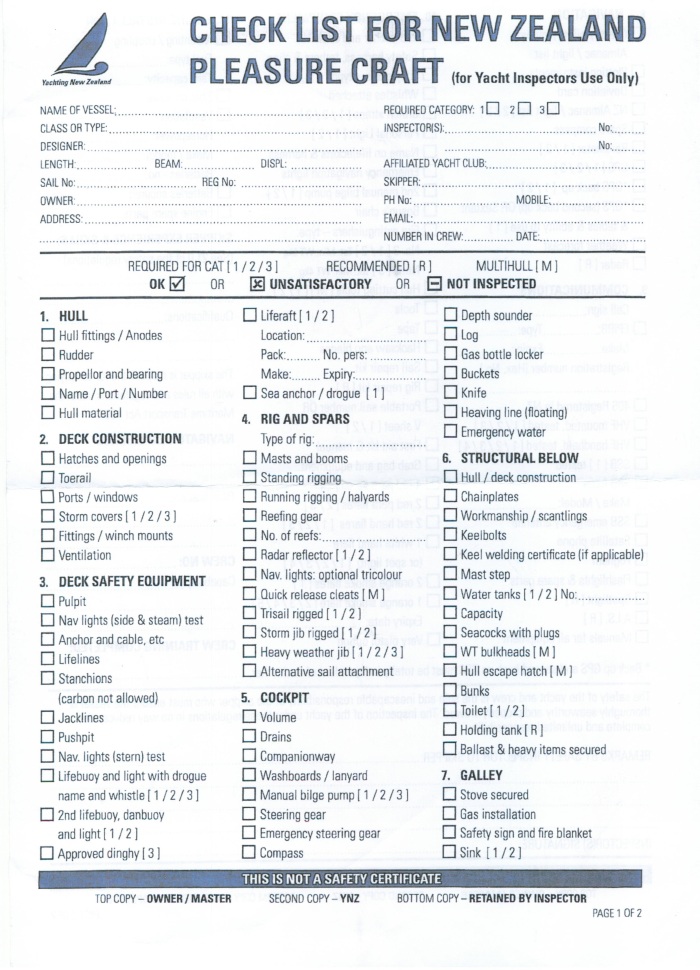
Share this:
Related posts.

Seasickness

Sailing Qualifications

Heavy Weather Tactics

Marine Medic

Flags & Signalling


Yachting NZ Medical Stores List

The Catlins Coast – New Zealand

5 thoughts on “ Yachting NZ Cat 1 ”
Pingback: Safety Equipment List | Astrolabe Sailing
Pingback: Ocean Yachtmaster | Astrolabe Sailing
Pingback: Coastal Skipper | Astrolabe Sailing
Pingback: Advanced Sea Survival | Astrolabe Sailing
Pingback: RYA Offshore Yachtmaster | Astrolabe Sailing
Leave a comment Cancel reply
This site uses Akismet to reduce spam. Learn how your comment data is processed .
- Already have a WordPress.com account? Log in now.
- Subscribe Subscribed
- Copy shortlink
- Report this content
- View post in Reader
- Manage subscriptions
- Collapse this bar

The global authority in superyachting
- NEWSLETTERS
- Yachts Home
- The Superyacht Directory
- Yacht Reports
- Brokerage News
- The largest yachts in the world
- The Register
- Yacht Advice
- Yacht Design
- 12m to 24m yachts
- Monaco Yacht Show
- Builder Directory
- Designer Directory
- Interior Design Directory
- Naval Architect Directory
- Yachts for sale home
- Motor yachts
- Sailing yachts
- Explorer yachts
- Classic yachts
- Sale Broker Directory
- Charter Home
- Yachts for Charter
- Charter Destinations
- Charter Broker Directory
- Destinations Home
- Mediterranean
- South Pacific
- Rest of the World
- Boat Life Home
- Owners' Experiences
- Interiors Suppliers
- Owners' Club
- Captains' Club
- BOAT Showcase
- Boat Presents
- Events Home
- World Superyacht Awards
- Superyacht Design Festival
- Design and Innovation Awards
- Young Designer of the Year Award
- Artistry and Craft Awards
- Explorer Yachts Summit
- Ocean Talks
- The Ocean Awards
- BOAT Connect
- Between the bays
- Golf Invitational
- Boat Pro Home
- Pricing Plan
- Superyacht Insight
- Product Features
- Premium Content
- Testimonials
- Global Order Book
- Tenders & Equipment
Classification: Statutory certification explained
Is certification an unnecessary complication, the costs and hassle of which far outweigh the benefits, or a helpful and reassuring framework which sets the highest standards for structural and operational safety and safeguards life, property and the sea environment?
No one could possibly deny that the large yacht industry is, and has been for some time, in the throes of a boom in spite of a recent downturn since 2008. Some observers would suggest that this is in spite of all the new rules and regulations that seem set to dog the yacht owner’s every move. Others would suggest that it is through the introduction of rules and regulations such as the MCA’s Code of Practice for Safety of Large Commercial Sailing and Motor Vessels that the industry has been given the confidence to expand with such vigour, knowing that their investments are safer – both financially and physically – because of regulation.
Classification societies are non-governmental organisations or groups of professionals, ship surveyors and representatives that develop, publish and certify standards and technical rules to ensure an acceptable degree of stability, safety and environmental impact, among other things. They are authorised to certify yachts and vessels flagged virtually anywhere.
A classification certificate attests that the yacht complies with the standards developed and published by the issuing society
New construction and refit surveys carried out by a surveyor from the classification society under which the yacht is built are important inspections that take place at intervals throughout the duration of the project. They ensure that any and every installation, repair, upgrade or modification is carried out to the standards of that society. Classification surveyors are interested in the structural integrity of the hull, installation of equipment, stability, structural, engine and machinery surveys, electrical, electronic and ancillary equipment, rigging inspections, safety recommendations and ultrasonic thickness gauging.
Every owner has his own vision of what he wants his yacht to be and designers strive to deliver just that. The fulfillment of this vision in turn becomes paramount in the eyes of the building yard and others who represent the owner, so it is often the policies imposed in the form of building regulations and classification rules that act as the voice of reason. This ultimately allows a balance to be struck between the attainment of that vision and the safety and reliability embodied in the construction of a yacht built to class.
A classification certificate attests that the yacht complies with the standards developed and published by the issuing society. Periodic surveying of a yacht in service by the appropriate class surveyor, at intervals dictated by the appropriate classification society, is also required to ensure the vessel continues to meet the rules and thus maintain her in-class status. Should any defects that may affect class become apparent, or if damage is sustained between surveys, the owner or operators are required to inform the society concerned without delay.
Almost every yacht that is launched is bigger or in some way better than the last and, quite often, more complex than its predecessor
As independent, self-regulating bodies, classification societies have no commercial interest in design, building, ownership, operation, management, maintenance, repairs, insurance or chartering. Classification rules are not intended as a design code and, in fact, cannot be used as such. These are more generally covered by the flag state, which lays down standards, or codes of practice that dictate construction good practice.
Almost every yacht that is launched is bigger or in some way better than the last and, quite often, more complex than its predecessor. As this trend continues, so too is the involvement and role of classification societies increasing and evolving. But what exactly does classification entail, and how is it linked to the statutory requirements of the various flag states? These matters are often misunderstood, which can potentially result in a conflict of responsibility.
Classification
The classification process The classification of yachts may be regarded as the development and worldwide implementation of published rules and regulations which – in conjunction with proper care and conduct on the part of the builder, owner and operator – provides for the structural strength and, where necessary, the watertight integrity of the hull. The same rules cover any appendages to the hull itself.
Classification rules lay down regulations that govern the effectiveness, safety and reliability of the propulsion and steering systems and other features, as well as the auxiliary systems which establish and maintain basic conditions on board and ensure that guests and crew can be safely carried while the yacht is at sea, at anchor, or moored inside a harbour.
Owners sometimes see classification as an unnecessary complication offering no real advantage for the cost. Some even suggest that the classification societies exist simply to make a profit out of a yacht builder’s desire to build a saleable product.
‘This is a misconception and one that needs to be addressed,’ Paul Martin, a principal engineer at DNV, points out: ‘Classification societies are independent bodies without a commercial stake in the build, and are therefore in a unique position to make sure that the yacht meets requirements without considering commercial impact. This enables yachts to be built with safety of the yacht, her crew, other vessels and the environment given maximum priority, irrespective of cost.’
Owners sometimes see classification as an unnecessary complication offering no real advantage for the cost
‘Because most classification societies have enormous experience,’ he continues, ‘as well as a lot of data on the failure of various types of vessels, machinery and other connected disciplines, they can bring these to bear on new projects ensuring fees are justified, and at the same time enhancing safety against the most up-to-date maritime knowledge and good safe practice.’
Yachts are said to be ‘in class’ when the classification society believes that its rules and regulations have been complied with, unless it has granted a special dispensation from compliance for a particular aspect. In order to decide whether a vessel should achieve in-class status surveyors appraise design, surveys and reports on the vessel’s construction, machinery, apparatus, materials, components, equipment, production methods and processes of all kinds for the purpose of verifying their compliance with plans, specifications and rules, codes of practice, or their fitness for particular requirements.
Class surveyors can also provide other technical inspection and advisory services relating to yachts and maintain these provisions during periodical visits to ascertain that the vessel is complying with classification society regulations at all times. Any modification which would affect class must always receive prior approval by the society.
When a yacht is going to be built to class, construction plans and all particulars relevant to the hull, equipment and machinery have to be submitted for the society’s approval before the work commences. Subsequent modifications or additions to the scantlings, arrangements or equipment shown on the approved plans must also be submitted for appraisal.
Implementation Statutory aspects deal with issues such as stability, life-saving appliances, pollution prevention and structural fire protection. Generally there are quite clear dividing lines between class and statutory requirements, although there are a few exceptions.
Flag states
The flag state, or nationality, of a yacht is important because it controls which country has the right to prescribe and enforce laws governing her operation. A ship must sail under the flag of a single state. The most common method by which a ship is granted the nationality of a state is by formal registration of the ship with that state.
Upon registration the ship acquires rights and duties as a result of registration which vary depending upon the state and the conventions and treaties to which it is party.
The rights will normally include action in an international court if there is a violation of international law against the vessel by another state, and representation at international conferences and organisations.
The duties include the upholding of the law of the flag state aboard the vessel, wherever she may be in the world.
Quality flags will also provide a recognised reputation for excellence, helping the vessel to avoid lengthy Port State Control inspections in foreign ports, and give worldwide support from embassies and consuls of that state and the protection of its navy.
International Maritime Organization
Statutory regulations are not only produced by the marine administrations of countries, but also the International Maritime Organization (IMO).
While some marine or flag administrations have the ability and knowledge to produce their own legislation, this is not true for the majority of countries. As shipping is an international business an international organisation is needed to regulate statutory issues. The United Nations established the IMO for the purpose of adopting the highest standards concerning matters of safety, navigation, and pollution prevention. The IMO held its first meeting in 1959 and now comprises 165 flag state members.
The United Nations established the IMO for the purpose of adopting the highest standards concerning matters of safety, navigation, and pollution prevention
The IMO’s purpose is to facilitate the general adoption of the highest practical standards in matters concerning maritime safety, efficiency of navigation and the prevention of marine pollution from ships among governments. Since its inception the IMO has introduced 40 conventions and protocols, although it is the responsibility of member countries to put these regulations into effect.
Statutory Implementation
The process of statutory implementation begins with the development and adoption of regulations by working groups at the IMO. Before these regulations come into force they have to have been accepted by a certain percentage of the IMO’s member states. This can take some time as each country has to introduce these statutory regulations as part of their maritime law before they can actually become mandatory on the ships registered in those countries.
It is important to understand that the IMO can adopt international legislation but that it remains the prerogative of the flag state to implement and enforce it. If a yacht registers with a country that has accepted these regulations then the yacht and her operators have to comply with them.
Maintenance of compliance is verified by a regular survey regime, which is the responsibility of the flag administrations and normally carried out by flag surveyors.
Not all flag administrations have the expertise or manpower to carry out the survey regime themselves, and they often delegate this work to classification societies
This arrangement means that the same class surveyor can issue certification on behalf of a flag state for compliance with, amongst other things, the MCA Large Yacht Code and Load Line Conventions. The class surveyor can also handle issues covered by the various annexes contained within the MARPOL Regulations, such as the prevention of oil, sewage and air pollution.
Class surveyors are often empowered by the state to inspect and certify crew accommodation, safety equipment, safety radio requirements, safety of navigation requirements, international tonnage, Suez and Panama Canal Tonnage Certification, and United States Coast Guard compliance. They are also frequently called on to service the requirements of SOLAS whenever a yacht becomes liable to comply with it.
Clearly, classification and statutory certification often go hand-in-hand where statutory certification requires classification of the yacht, and where a classification society requires valid statutory certification for the class to be valid.
In the preparation of this article the authors gratefully acknowledge the help they received from:
Engel JW de Boer – Service delivery manager, Lloyd’s Register, Rotterdam, The Netherlands
Mario Dogliani – Corporate affairs and communication, RINA, Genoa, Italy
Jean-Jacques Juenet – Commercial manager, Bureau Veritas (BV), Paris, France
Paul Martin – Det Norske Veritas (DNV), Houston, USA
John Guy – Merlin Corporate Communications, London, UK
Nick Gladwell – Regs4yachts, Southampton, UK
Originally published: May 2008.
More stories
Most popular, from our partners, sponsored listings.
- Yachting Monthly
- Digital edition

ARC safety checklist
- January 10, 2006
Compare your safety gear with what's required to join the ARC
In the February 2006 issue of YM, Miles Kendall looks at the range of crews who crossed the Atlantic with the ARC. He also lists some of the common safety failures found by the event’s scrutineers.
Below, courtesy of the World Cruising Club, organisers of the ARC and YM Rally Portugal, are the safety equipment requirements for ARC entrants.
WORLD CRUISING CLUB SAFETY EQUIPMENT REQUIREMENTS
The following safety equipment requirements have been drawn up to ensure the minimum level of safety for yachts participating in World Cruising Club Events. The ISAF Offshore Special Regulations have been used as a guideline to compile these regulations.
Divisions II (Racing) and VIII Invitation Racing are ISAF Offshore Special Regulations for Category 1 and these Safety Equipment Requirements.
These safety equipment requirements do not override any greater safety requirement demanded by the yacht’s national, or flag country, maritime authorities or appropriate regulatory bodies.
Yacht owners considering taking fare paying guests or crew should consider the implication in relation to their national or flag regulations as required by the appropriate proper authorities.
The regulations are in two sections:
Section One – Mandatory Safety Equipment Requirements.
This equipment must be carried and all items will be sighted during the safety equipment inspection prior to the start. Failure to comply may lead to disqualification from the Rally.
Section Two – Recommended Safety Equipment.
Whilst equipment in this section is not mandatory the organisers strongly suggest that all the recommendations in this section are complied with. The Safety Equipment Officer will be available to discuss points made in this section during his inspection.
GENERAL REQUIREMENTS
It is the entire sole and inescapable responsibility of each skipper to ensure that all necessary safety precautions whatsoever are taken in respect of himself the crew and the yacht.
All safety equipment that requires regular servicing must be in date, at the start of the Rally, and remain in date for the duration of the Rally. (The Test Certificate for the liferaft will be inspected during the Safety Equipment Inspection).
All safety equipment carried must: a. be of type, size and capacity commensurate with the size of yacht b. function correctly c. be easily accessible
Each crew member must be fully conversant with the operation of all safety equipment carried and know its stowage positions.
SECTION ONE MANDATORY SAFETY EQUIPMENT REQUIREMENTS
Liferaft: A purpose made, self inflating, liferaft of sufficient places to carry all the crew shall be either:
i.) A SOLAS model, or
ii.) An “ORC” model in compliance with ISAF Offshore Special Regulations Appendix A Part I provided that the liferaft was manufactured before 01/2003, or
iii.) An “ISAF” model in compliance with ISAF Offshore Special Regulations Appendix A Part II, or iv) An “ISO Standard 9650” Type 1 Group A with service Pack 1 (>24 hours).
Each raft shall be capable of being got to the lifelines within 15 seconds. Each liferaft shall have a valid inspection certificate from the manufacturer or approved servicing agent, valid for the period of the Rally. The certificate, or a copy, shall be carried on the yacht. (See ISAF website [www.sailing.org/rules/] for the full text of the ISAF Offshore Special Regulations).
VHF: A VHF radio transceiver having a rated output power of 25W and capable of working on all standard international channels must be fitted. An external cockpit extension speaker should also be fitted to the set. The radio shall have a masthead antenna and an emergency antenna shall also be carried.
Long Range Communications Equipment: each yacht will be required to report their position daily directly to worldcruising.net, via Inmarsat C, D , or other system capable of sending an E-mail message whilst at sea.
EPIRB: An Emergency Position Indicating Radio Beacon. A Satellite EPIRB transmitting on 406MHz or an Inmarsat type “E” EPIRB is required, correctly registered with the appropriate authority.
Radar Reflector: Permanently mounted in, or capable of being hoisted to, a position at least 5m (15 feet) above deck. Octahedral reflectors must have a minimum diagonal measurement of 18in (457mm). Any reflector other than octahedral, must have a documented RCS (radar cross-section) of not less than 10sq.m.
Flares: Flares stowed in a watertight container, with as a minimum:
6 red parachute flares 4 white hand held flares 4 red hand held flares 2 orange smoke
Lifebuoys, within reach of the helmsman for instant use: 1. One lifebuoy with a drogue, or a lifesling (without a drogue), with a self igniting light and whistle attached, and 2. One lifebuoy, or a MOB Module, equipped with a whistle, drogue, a self igniting light and a pole and flag (a danbuoy).
At least one lifebuoy shall either be a lifesling or have permanent (e.g. foam) buoyancy. Every inflatable lifebuoy shall be tested at intervals in accordance with its manufacturer’s instructions. Each lifebuoy shall have the yachts’ name painted on them and must be fitted with marine grade retro-reflective material.
Bilge pumps: One manual bilge pump securely fitted, operable from on deck with companionways and hatches shut. (It is recommended that a second manual bilge pump, operable from below decks, is also fitted). Unless permanently fitted, bilge pump handles shall be provided with a lanyard, securely attached, and catch, or similar device, to prevent accidental loss.
Navigation lights: Navigation lights must be fitted so that the yacht shall, at all times, comply with the International Regulations for Preventing Collision at Sea. Two independent sets of navigation lights are required. For example, the primary set (bow and stern lights), the secondary set (masthead tricolour); flashlight/torch battery operated, handheld lights are not acceptable. Spare bulbs of correct wattage shall also be carried.
Harness: If separate from a combined lifejacket/harness, shall have a safety line not more than 2 metres long with a strap hook at each end. It is recommended that a second snap hook should be placed at the middle of the point line. Each harness shall have a crotch strap. There shall be a harness and safety line provided for each member of the crew.
Lifejacket/Combined Harness: Shall have a whistle, a light, yacht name, retro-reflective tape, a crotch strap and a safety line not more than 2 metres long with a snap hook at each end . It is recommended that a second snap hook should be placed at the middle point of the line. There shall be a lifejacket/combined harness provided for each member of the crew.
Heavy equipment: All heavy equipment (i.e. anchor, batteries, gas bottles and stoves) shall be firmly secured to prevent damage from possible knockdown or capsize.
The following equipment shall also be fitted/carried:
Emergency grab bag (see Appendix 1) A recognised secondary or alternative method of navigation Securely fitted taut double lifelines around the entire deck Jackstays along port and starboard side decks Fire extinguishers (at least two) Fire blanket (secured near the galley) Companionway washboards to be capable of being secured shut and with lanyards to prevent accidental loss Softwood plugs – securely attached adjacent to each fitting to enable any through hull fitting to be closed off Throwing line 15m – 25m (50ft – 75ft) length, readily accessible to cockpit High powered search light Emergency tiller or secondary steering device Hacksaw and spare blades (Bolt croppers for yachts with rod rigging) First aid kit and manual Foghorn Buckets (at least two) of stout construction and fitted with lanyards; capacity to be at least 2 gallons (9 litres) Echo sounder and log SECTION TWO RECOMMENDED SAFETY EQUIPMENT
It is recommended that the following equipment be carried:
Dinghy and oars Handheld VHF transceiver Nautical almanac Charts and pilots for the route taken by the Rally Sextant and tables Water resistant torch with spare bulb and batteries Storm jib Storm trisail or deep reef in mainsail A second manual bilge pump operable from below deck White parachute flares (to provide illumination for Search and Rescue) Maststep. The heel of a keel-stepped mast should be securely fastened to the maststep or adjoining structure Drogue or Sea Anchor. A drogue (for deployment over the stern), or alternatively a sea anchor, or parachute anchor (for deployment over the bow), is strongly recommended as a means to reduce the risk of capsize in heavy breaking seas
It is highly recommended that each person on board carries a knife at all times whilst at sea
APPENDIX 1 GRAB BAG CONTENTS
The ORC recommends that a “grab bag” accompanies each liferaft. The following contents are recommended and should be appropriately packed and waterproofed (packing should be openable by wet fingers without tools):
second sea anchor and line two safety tin openers waterproof hand-held VHF transceiver EPIRB a first aid kit one plastic drinking vessel graduated in 10, 20 and 50 cubic cm two “Cyalume” sticks or two watertight floating lamps one daylight signalling mirror and one signalling whistle two red parachute flares and three red hand flares non-thirst provoking rations and barley sugar or equivalent at least half a litre per person of drinking water in a dedicated and sealed container one copy of the illustrated table of life-saving signals nylon string, polythene bags, seasickness tablets
Contents of the grab bag are not necessarily additional to the items required by the Safety Equipment Regulations – the grab bag offers a suitable place to stow items where they will be quickly found or readily carried to the liferaft.
To learn more about World Cruising Club events, visit www.worldcruising.com
The information contained on this page belongs to World Cruising Club and cannot be copied or reproduced without permission.

- CLASSIFIEDS
- NEWSLETTERS
- SUBMIT NEWS
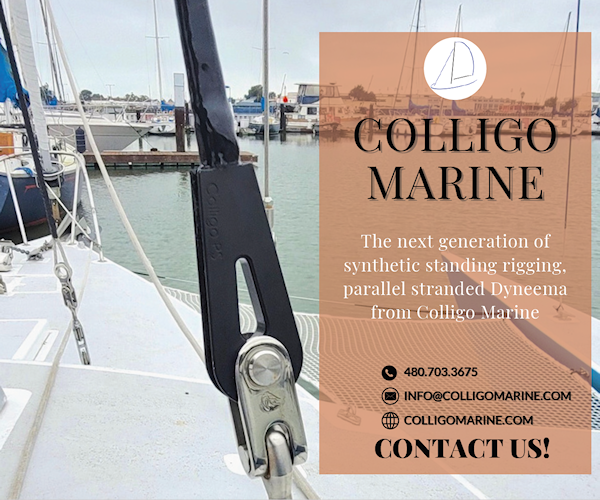
Toughest safety requirements for Sydney-Hobart race

Related Articles
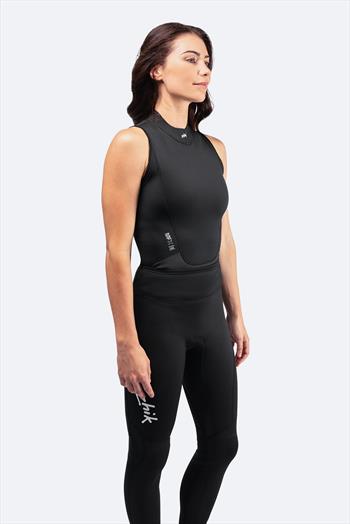
- TRAILER SAILER
- DOCUMENTS AND FORMS
- CLUB MARINE MAGAZINE
- MEMBER REWARDS
- CLUB MARINE ASSIST
- SERVICE PROVIDER LOCATOR
- MANAGE OR RENEW YOUR POLICY
- MAKE A CLAIM
- COMPLAINTS AND DISPUTES
- ADDITIONAL SUPPORT
- FINANCIAL HARDSHIP
- SEVERE WEATHER PREPARATION
Boating safety equipment checklist
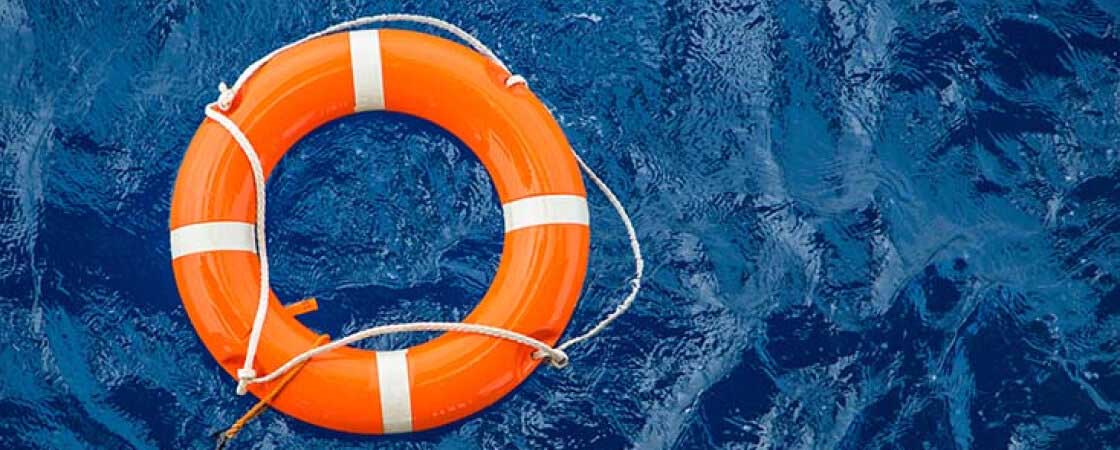
Equipment requirements for recreational boating are different between states, with variables and exemptions relating to the size and type of vessel as well as factors like operating area and distance from land.
Check the full equipment lists available online from the relevant state boating and national yachting authorities.
All vessels
- Inshore (less than 2NM off coastline)
- Offshore (more than 2NM off coastline)
- Second anchor, chain and rope
- First aid kit
- Antiseptic solution
- Adhesive strips, bandages, dressing pads
- Paracetamol
- Surgical scissors
- First aid pamphlet and resuscitation chart
- Safety blanket
- Seasickness tablets
- Fresh drinking water
- Engine spare parts and new spark plugs
- Electrical spares
- Screwdrivers
- Adjustable spanners
- Bolt or wire cutters
- Hose clamps
- Electrical tape
- Mask and snorkel
- Signalling mirror
- Marine strobe (intense strobe light visible up to 3.2km)
- Dye marker (luminescent green dye released into the sea, covers approximately 50 metres)
- Radar reflector
- Emergency steering
- Display flags (N over C)
- Spare propeller
Required for inshore boating (less than 2NM off coastline)
- Make sure everyone onboard knows how to use the safety equipment
- Make sure items like lifejackets, flares and emergency beacons (EPIRBs) remain easily accessible
- Regularly check expiry dates on all equipment and replace as needed
- Lifejackets - level 50S or greater, one per person (check local regulations for usage and exemptions)
- Anchor and chain or line
- Bailer or bucket with lanyard
- Bilge pump - manual or auto (for vessels with covered bilge)
- Fire extinguisher (required on all vessels with electric start, electric motors, battery or stove)
- Sound signal – air horn, whistle or bell
- Waterproof torch – floating and operational
- Paddles or oars (vessels under 6 metres) unless auxiliary propulsion is fitted
- Navigation lights (sunset to sunrise)
Required for offshore boating (more than 2NM off coastline)
- Lifejackets - level 100 or greater, one per person (check local regulations for usage and exemptions)
- Inflatable lifejackets must be serviced in accordance with manufacturer’s instructions
- Inflatable lifejackets are not recommended for non-swimmers and children
- Hand-held orange smoke flares – minimum of 2
- Used in daylight
- Visible up to 10km by aircraft
- Must comply with Australian Standard AS 2092
- Hand-held red flares – minimum of 2
- Visibility range of 10km
- For use at night but can also be seen in daylight
- Must comply with Australian Standards AS 2092
- Red star parachute distress rocket – optional
- Fires a single red star to approximately 300m
- Burns for at least 40 seconds with a visibility range of potentially 40km
- Required by many vessels venturing more than 5 nautical miles offshore
- White parachute flare – optional
- Specialised flare used to illuminate search/rescue area
- Marine radio - 27 MHz, VHF or HF
- All operators of marine radios (except 27 MHz) are required to hold appropriate licence to operate the device
- Can be supplemented with a mobile phone for coastal boating
- EPIRB (Emergency Position Indicating Radio Beacon)
- 406 MHz (must be registered with AMSA and in date)
- A Personal Locator Beacon (PLB) may be carried in addition to a 406 EPIRB as an extra precaution
- Compass - can be augmented by a GPS unit
- Map - paper (not electronic) chart for area of operation
- V sheet - orange with black vee
- Drinking water - 2 to 4 litres per person, depending on State
- Lifebuoy - legally required on vessels greater than 8 metres in some States
- Life raft - National Marine Safety Committee recommends all recreational vessels going more than 2nm offshore carry a life raft or dinghy
- Mandatory on Category 1 and 2 offshore racing yachts
- Mandatory in South Australia on boats over 15m operating offshore
- Victoria requires life raft or dinghy for boats 12m + operating 2nm from shore
- Equipment and rations should comply with Australian Sailing or SOLAS regs
RELATED ARTICLES
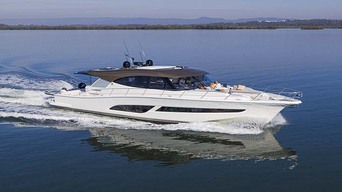
Riviera 585 SUV boat test
Riveria’s new 585 SUV feels just right from the moment you step aboard
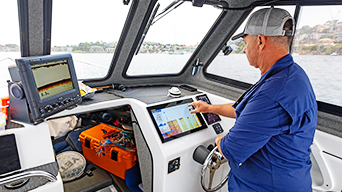
How to use fishfinders
Al McGlashan explains how to get the most out of your fishfinder
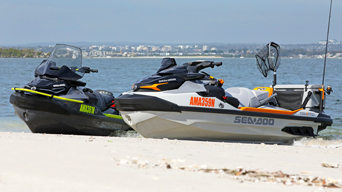
Sea-doo explorer pro and fishpro trophy

Cheesecake with prosecco strawberries recipe
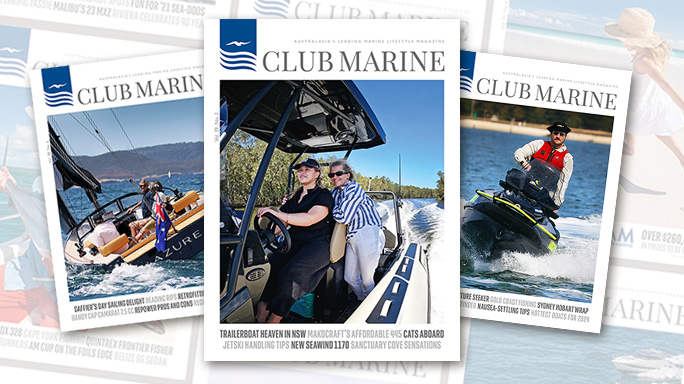
Club Marine Magazine Preview
Preview of the Club Marine Magazine

Crisp and Soft Tacos With Apple Slaw Recipe
From the pages of The Hunter and The Gatherer, by long-term cruising sailors Catherine Lawson and David Bristow.

Mud Crab Risotto recipe
Ormeggio at The Spit, Sydney, is a hatted Italian restaurant with a refined seafood menu that includes this exquisite mud crab risotto.
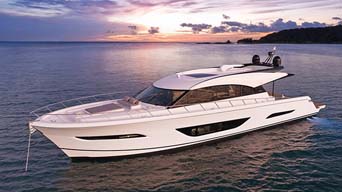
Maritimo S75 boat test
Big things are expected of Maritimo’s largest-ever motor yacht.
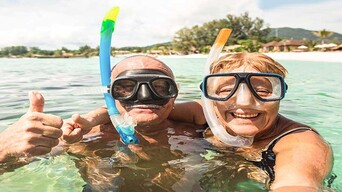
Top lifestyle boats
From a watertoy to a picnic cruiser, here are 10 top picks for boating boomers and late bloomers ... or for anyone looking to up- or downsize their boat.

Hiramasa kingfish crudo recipe
This elegant kingfish recipe is courtesy of San Martin, at d'Albora Marina Akuna Bay.
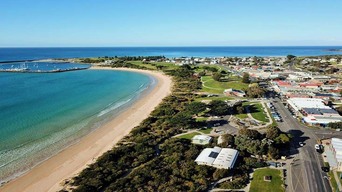
Destination Apollo Bay Victoria
Cruise the iconic Great Ocean Road and stop at Apollo Bay for its beautiful beach and sensational food.
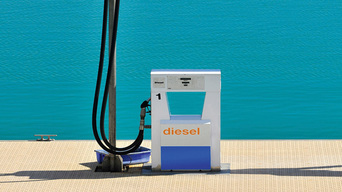
Refuelling a boat or jet ski
There’s a bit more to topping up the tank than cruising up to a bowser and filling 'er up – here are our top tips for safe refuelling of boats and jet skis.
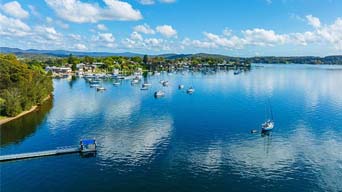
Lake Macquarie NSW boating destination
Lake Macquarie is a multifaceted gem for calm-water boating and fishing.
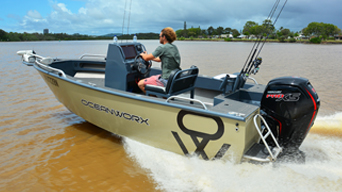
Oceanworx axcess 5.3 centre console boat test
OCEANWORX AXCESS 5.3 CENTRE CONSOLE BOAT TEST
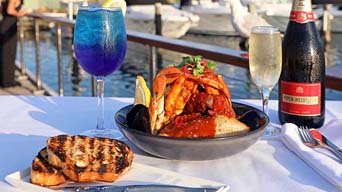
Singapore hotpot recipe
Guests at Crusoe’s on the Lake enjoy views across Lake Macquarie while dining on local specialties, including this delicious Singapore hotpot.
WE'RE HERE TO HELP
Follow us on, *terms and conditions apply.
- Trailer Sailer
- Documents and Forms
- Club Marine Magazine
- Advertise with Us
- Member Rewards
- Club Marine Assist
- Service Provider Locator
- Manage Policy
- Renew Policy
- Make a Claim
- Additional Support
Any advice here does not take into account your individual objectives, financial situation or needs. Terms, conditions, limits and exclusions apply. Before making a decision about this insurance, consider the Product Disclosure Statement (PDS)/Policy Wording and Supplementary PDS (if applicable). Where applicable, the PDS/Policy Wording, Supplementary PDS and Target Market Determination (TMD) for this insurance are available on this website. We do not provide any form of advice if you call us to enquire about or purchase a product.
Club Marine Limited (ABN 12 007 588 347), AFSL 236916 (Club Marine) issues this insurance and handles and settles claims as agent for the insurer Allianz Australia Insurance Limited (ABN 15 000 122 850) AFSL 234708 (Allianz). Club Marine is a related body corporate of Allianz. Copyright © 2024 Allianz Australia Limited
This website may not work correctly because your browser is out of date. Please update your browser .
- Safety Regulations
Safety Categories
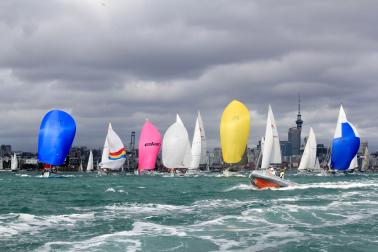
Yacht races are classified as either category 5, 4, 3, 2 or 1 in the sailing instructions or notices of race.
Category 4 or 5 is, in general, round-the-buoys type or short course racing in sheltered or warm waters. Compliance is self-regulated and requires only a skipper's declaration. Skippers should be aware that, in the event of a spot check, failure to comply may result in disqualification.
Category 3, 2 or 1 classifications refer to offshore and ocean races with different categories specified depending on the distance, duration and location of the race. Skippers must be able to present a current safety inspection certificate seven days prior to the start of a category 3, 2 or 1 race.
Category 1 safety certificates are also required by all (racing and cruising) New Zealand-registered vessels leaving New Zealand on ocean passages for overseas.
More information about taking your boat overseas here.
Category definitions
Ca t ego r y 0
Yachts in m a jo r t r a n s - o c ea n r a c e s m u s t b e c omp l e t e l y s e l f - s u f f ic i e n t f o r e x t en de d p e r i od s o f t i m e, c a p a bl e o f wi t h st andin g he a v y s to rm s an d p r ep a r e d t o me e t s e r io u s e m e r g e n c i e s wi t ho u t t h e e xpe c t at io n o f o u t s id e a s s i st a n c e . They w il l pa s s t h r oug h a r e a s i n w h ic h a i r o r s e a t em p e r at u re s a r e like l y t o b e l es s t ha n 5 de g r e e s C e l s i u s ot he r t ha n t em p o r a r i l y .
Ca t ego r y 1
P a s sag e o r r a c e s o f l on g d i st a n c e s an d w el l o f f s ho r e, w he r e y a c h t s m u s t b e c omp l e t e l y s e l f - s u f f ic i e n t f o r e x t en de d p e r i od s o f t i m e, c a p a bl e o f wi t h st andin g s to rm s an d p r ep a r e d t o me e t s e r io u s e m e r g e n c i e s wi t ho u t t h e e xpe c t at io n o f o u t s id e a s si s t a n c e.
Ca t ego r y 2
R a c e o f e x t en de d du r at io n a l on g o r n o t f ar r e m o v e d f r o m s ho r elin e s o r i n l a r g e unp rot e c te d b a y s o r lak e s , w he r e a hig h de g r e e o f s e l f - s u f f ic i e n c y i s re qui r e d b u t wi t h t h e r e as ona bl e p r o b abil i t y t h a t o u t s id e a s s i st a n c e c ou l d b e c a l le d u p o n f o r a i d i n t h e e ve n t o f s e r io u s e m e r g e n c i es .
Categor y 3
R a c e s a c ro s s o p e n w at e r , mo s t o f w h ic h i s r el at i ve l y p rot e c te d o r c l o s e t o sho r elin e s .
Ca t ego r y 4
Sho r t r a c e s , c los e t o s ho r e i n r el at i ve l y w a r m o r p rot e c te d w a t e r s .
Ca t ego r y 5
S ho r t r a c e s , i n s id e ha r b o ur li m it s o r wi t h i n f u l l y p ro t e c t e d w a te r s to C a t e go r y 4 o r 5 a r e , i n g ene r al, r o u n d - th e - bu o y s - t yp e racing o r s ho r t c o u r s e, h ar bo u r an d ins hor e r a c ing.

IMAGES
COMMENTS
Category 1 Safety Inspections. Yacht inspections are made visually and are for the purpose of verifying whether a vessel, its equipment, and crew are safe to undertake an overseas voyage or enter races organised by Yachting New Zealand- affiliated clubs. The inspection certificate may not be used for any other purpose by any person.
Yachting New Zealand safety regulations of sailing - part 1. Regulation for unballasted centreboards and open yachts, sailboards and ballasted yachts are found in the Yachting New Zealand Racing Rules of Sailing. The 2021-2024 regulations are available for download by clicking here. These regulations are applicable to racing yachts and to New ...
The key differences between the Safety Equipment Requirements (SER) and the World Sailing OSRs are as follows: The SERs are easier for yacht owners and pre-race inspectors to understand. The SERs are self-contained and do not refer to external documents. The number of race categories has been reduced from seven to three: Nearshore, Coastal, and ...
End to end process flowchart of gaining a Category 1 certificate and departing NZ (V11) 1. Decision to go offshore. 2. Access information on the process and requirements for pleasure craft departing NZ (YNZ and MNZ websites and direct contact with either/both organisations) 3. Read the YNZ Safety Regulations of Sailing.
Again, the additional requirements of the Cat 1 safety regulations cover the differences between coastal and offshore racing in a comprehensive, yet reasonable, way. The Yachting Australia special regulations applicable to Cat 1 races also contain additional, albeit minor, requirements for yacht structural integrity and stability from those ...
A boat with moveable or variable ballast (water or canting keel) shall comply with the requirements of Appendix K. x x x Hull and Structure: Accommodations 2.3.1 A boat shall be equipped with a head or a fitted bucket. x Hull and Structure: Accommodations 2.3.2 A boat shall have bunks sufficient to accommodate the off watch crew. x Hull and ...
the safety and communication equipment meeting specific requirements and ensuring all safety equipment is well within its expiry date; ... below flow chart to assist you in following the correct process to obtain a Category 1 safety certificate to take your boat overseas. Getting a Category 1 safety certificate [PDF: 103kB, 1 page] ...
In this yacht safety guide, we'll focus on what areas to inspect prior to departure, what equipment to have aboard, how to file a float plan, which emergency procedures to practice, and which key supplementary items to include to enhance your boating experience. Safety Inspection. Float Plans. Boat Safety Equipment.
Category 1 - 50nm to 200nm offshore. Passage or races of long distances and well offshore, where yachts must be completely self-sufficient for extended periods of time, capable of withstanding storms and prepared to meet serious emergencies without the expectation of outside assistance. Category 2 - up to 50nm offshore. Race of extended ...
Inspection costs. The full cost of an inspection is dependent on the time spent by the yacht inspector. The safety certificate is $115 for members of a Yachting New Zealand affiliated club. There is an additional cost of $75 for owners who are not a member of an affiliated club. These costs do not include the inspector's time and travel.
Yachting NZ Cat 1. Viki Moore / March 24, 2014. If you own a New Zealand registered yacht and are planning on sailing it offshore, you need to comply with the Yachting NZ Category 1 safety regulations. As NZ is many hundreds of miles from any other countries, these safety regulations mean that boats are seaworthy and equipped with all the gear ...
Yacht classification definitions. The yachting industry is still adapting to regulations and conventions which apply to private and commercial vessels alike. The merchant shipping sector is ruled by safety regulations developed since the beginning of the 20th century, and is familiar with international conventions such as SOLAS, MARPOL and Load ...
Report of casualty or accident (33 CFR 173.55) The operator or owner of any recreational boat is required to file a Boating Accident Report if the boat is involved in an incident that results in any of the following: Loss of life. A person disappears from the vessel under circumstances that indicate death or injury.
A classification certificate attests that the yacht complies with the standards developed and published by the issuing society. Periodic surveying of a yacht in service by the appropriate class surveyor, at intervals dictated by the appropriate classification society, is also required to ensure the vessel continues to meet the rules and thus ...
Divisions II (Racing) and VIII Invitation Racing are ISAF Offshore Special Regulations for Category 1 and these Safety Equipment Requirements. These safety equipment requirements do not override any greater safety requirement demanded by the yacht's national, or flag country, maritime authorities or appropriate regulatory bodies.
NOTE: Yacht Inspectors may use their discretion as to the acceptability of items not listed. 3.10 Change from: Skippers of vessels over 20m and vessels that have been in MOSS (Maritime Operator Safety System) requiring a Category 1 certificate for customs clearance should contact a yacht safety inspector who must consult with Maritime New Zealand.
The World Sailing Offshore Special Regulations (OSR) govern offshore racing, structural features, yacht equipment, personal equipment and training.
** 1.03.3 The word "yacht" shall be taken as fully interchangeable with the word "boat" SECTION 2 - APPLICATION & GENERAL REQUIREMENTS ** 2.01 Categories of Events Organizing Authorities shall select from one of the following categories and may modify the OSR to suit local conditions. MoMu0 2.01.1 Category 0
required. This is particularly important for Category 2 and 1 inspections. Please allow plenty of time for an appointment. The Yacht Inspector will visit your vessel and carry out a thorough check of the boat and its equipment as per the requirements set out in these regulations. An inspection certificate will be issued once the Yacht Inspector is
Toughest safety requirements for Sydney-Hobart race. by Peter Campbell on 25 Dec 2001. The 75 yachts competing in the 57th CYCA Sydney Hobart Yacht Race have completed the most stringent-ever safety preparations in the history of the 630 nautical mile ocean classic. When they set sail tomorrow, Boxing Day, 26 December, at 1pm the 800-plus crew ...
Life raft - National Marine Safety Committee recommends all recreational vessels going more than 2nm offshore carry a life raft or dinghy; Mandatory on Category 1 and 2 offshore racing yachts; Mandatory in South Australia on boats over 15m operating offshore; Victoria requires life raft or dinghy for boats 12m + operating 2nm from shore
Yachting New Zealand Safety Regulations 2021-24. The Yachting New Zealand Safety Regulations 2021 - 2024 are found here in a searchable PDF format. You can click on the index to take you directly to the section you are after. Alternatively, you can type Ctrl +F to be able to search or find a word.
Skippers must be able to present a current safety inspection certificate seven days prior to the start of a category 3, 2 or 1 race. Category 1 safety certificates are also required by all (racing and cruising) New Zealand-registered vessels leaving New Zealand on ocean passages for overseas. More information about taking your boat overseas here.